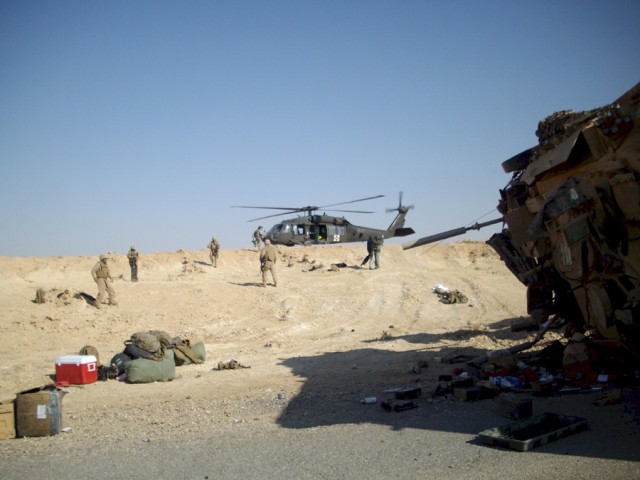
The Soldier's Creed states, "I will never leave a fallen comrade." Army Civilian and contractor employees feel the same way.
On Jan. 14, a convoy supporting the U.S. Army Engineering and Support Center's Coalition Munitions Clearance (CMC) program encountered two Marine Corps M-1 tanks involved in a serious accident on a remote road in Western Iraq.
The accident left the Marines' communication equipment and main guns inoperative and one of the six Marines seriously injured.
The convoy personnel, that included CMC project management specialist Tim Bohannon and 22 employees of security contractor Armor Group Inc. (AGI), set up a security perimeter and treated the injured Marine until the medical evacuation helicopter and the Marine Corps Quick Reaction Force (QRF) arrived.
"Needless to say, these Marines were in a very vulnerable position," Bohannon said. The CMC program has lost more than 40 contractor personnel during convoys from site to site because of insurgent activities, so they were aware of the danger the Marines faced. The CMC program is responsible for receiving, transporting, segregating and destroying captured or any other munitions posing a danger in Iraq. Storage and disposal of the ammunition is performed at several locations throughout Iraq.
"When faced with a situation like this, your personal well-being takes a back seat to protecting the fallen service member. Once on scene, it became our duty to protect these fallen comrades, and ensure they received medical attention as quickly as possible," Bohannon said. "I believe no one in the coalition would have done any less."
The accident is still under investigation, but it appeared that one tank was towing the second tank when the tank being towed "threw a track," and both tanks ended up on their sides. Bohannon credits AGI team leader Keith Morpus' professional demeanor and quick thinking with the success of the rescue.
"In my opinion, Keith, as well as all other members of the Armor Group security team, acted bravely and professionally," Bohannon said. "Keith was on the radio even before we arrived informing his teammates of what was going on and what he was seeing. Keith, and the other team leaders, kept a constant flow of information going so that no team member was uninformed."
Bohannon also credits the Marines with their quick thinking and grace under pressure.
"One Marine decided that since they had no commo they would throw a smoke grenade to try and get someone's attention," Bohannon said. "We would have come across the wreck site anyway, but the smoke did put us on alert."
Bohannon also credits Armor Group and the Department of Defense for the exceptional training they have that allows personnel to effectively handle just such a dangerous emergency situation.
"Both Armor Group and DoD train their employees in the very same types of emergencies we saw here. Establishing and maintaining a proper security perimeter, evaluation casualties and calling in MEDEVAC are all things taught in the military and reinforced with specific pre-deployment and in-country training," Bohannon said.
The CMC program has approximately 10 Department of the Army civilians, 601 contractor employees and 794 local nationals in Iraq supporting its mission right now. And this wasn't the first incident where CMC personnel have supported the coalition forces in a dangerous situation.
Bill Sargent, Huntsville Center's chief of international operations for the Ordnance and Explosives Directorate, recalls two other instances where CMC personnel helped the military in potentially catastrophic situations. According to Sargent, last June a CMC convoy was approaching a bridge when an insurgent detonated his vehicle under the bridge.
"Our contractors attached with Corps of Engineers personnel assisted the Soldiers in securing the site and initiated actions to rescue trapped soldiers," Sargent said.
In a second incident, an Army helicopter experienced mechanical problems and set down near a CMC mobile site.
"Our folks were watching them and we made sure no one slipped up on them. They were alone in the desert," Sargent said. "We then dispatched a security team to secure the site and get the helicopter crew into a secure environment."
The CMC mission has played a major role in reducing the availability of former Iraqi munitions to insurgents by destroying more than 400,000 tons since the program began in 2003.
"Obviously, our mission to destroy former Iraqi munitions which could be used as IEDs (Improved Explosive Devices) is extremely important to the overall mission in Iraq. But ancillary to this main mission is direct and indirect support to coalition forces," Bohannon said. "This comes in many forms such as providing emergency assistance, such as this tank incident, and sharing intelligence with the Marine Corps and Army gathered from convoy mission and from the CMC high tech surveillance equipment it employs at certain sites. In addition, our remote sites occasionally host nearby Marine Corps and Army units and provide much needed hot meals, MWR (Morale, Welfare and Recreation) facilities and safe havens when need."
The CMC convoy was only delayed about an hour, but according to Bohannon, it was a very worthwhile 60 minutes.
"The AGI personnel all did an outstanding job and potentially saved the lives of all these Marines. If we had not come along in a timely fashion, insurgents may have played a role in these Marines' futures."

Social Sharing